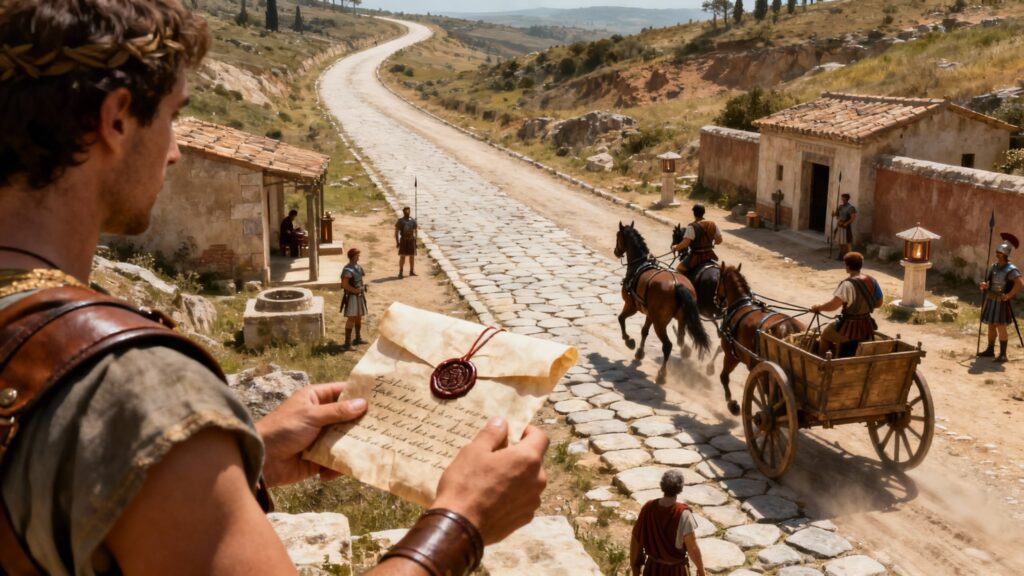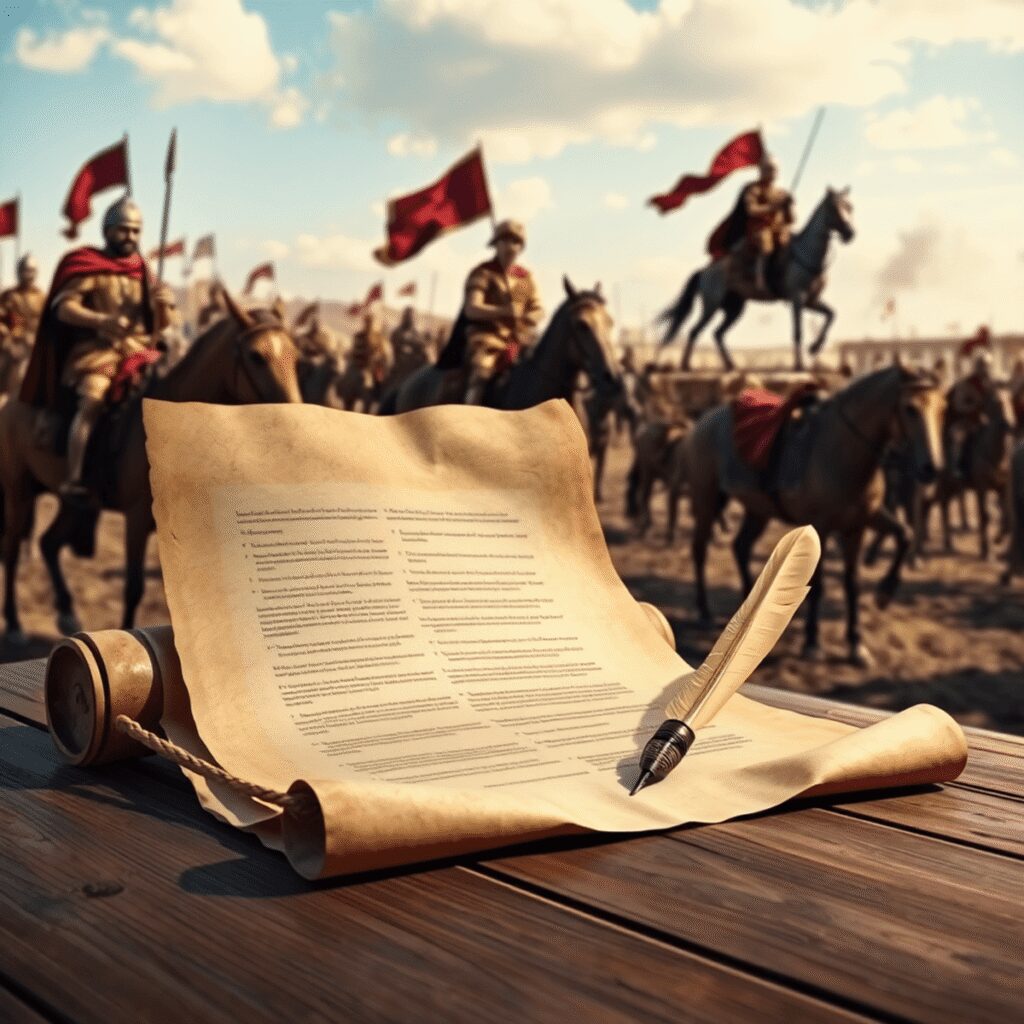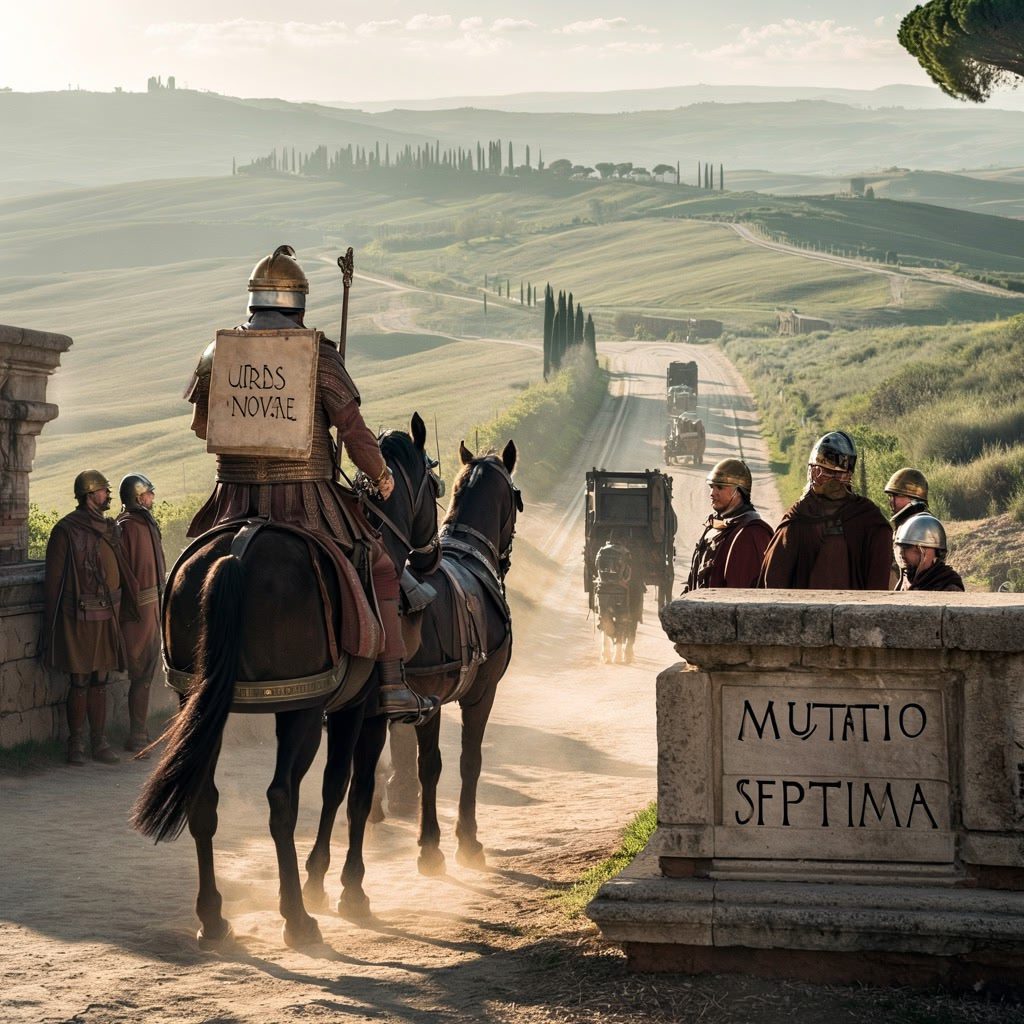Roman letter writing was a cornerstone of communication in the Roman Empire, bridging vast distances and diverse cultures. This art of ancient correspondence enabled efficient governance, military coordination, and social interaction across one of history’s largest empires. Letters were not merely messages but instruments of power, diplomacy, and personal connection.
Understanding the art of Roman letter writing reveals much about the empire’s administrative skill and cultural sophistication. It highlights how written words helped sustain an empire spanning continents. For instance, effective military coordination was significantly supported by the efficient communication facilitated through these letters.
The Roman military machine was not merely a collection of soldiers; it was a well-oiled apparatus that combined discipline, strategy, and innovation. At its peak, the Roman army was a reflection of the empire itself—vast, diverse, and intricately structured.
In this article, you will learn:
- How the cursus publicus, Rome’s postal system, managed official communication
- The infrastructure and personnel behind swift message delivery
- The role of rhetoric in crafting persuasive letters
- Broader communication methods beyond letter writing
- Techniques ensuring privacy and authenticity in correspondence
- The lasting impact of Roman letter writing on modern communication systems

The Cursus Publicus: Rome’s Advanced Postal System
The cursus publicus was the backbone of communication within the Roman Empire. Established by Emperor Augustus, this imperial courier network served as the official postal system, designed to facilitate rapid and reliable correspondence for government and military purposes. Its creation marked a significant advancement in administrative efficiency, allowing messages and orders to traverse vast distances with unprecedented speed.
An Extensive Road Network
The Roman road network supporting the cursus publicus stretched over 120,000 kilometers, connecting provinces from Britain to Egypt. These well-maintained roads formed an extensive infrastructure that enabled couriers to travel quickly across diverse terrains. The system was highly organized, with stations spaced at regular intervals to support continuous movement.
Two Main Types of Services
Two main types of services operated within the cursus publicus:
- Cursus clavularis: This service employed carts or wagons to transport heavier loads and larger quantities of official documents or supplies. It was slower but capable of handling bulkier cargo.
- Cursus velox: Designed for speed, this service used horseback riders who could cover long distances rapidly, ensuring urgent messages reached their destinations swiftly.
The Role of Couriers
Couriers traveled along these routes carrying official letters, military dispatches, and administrative instructions. The dual-service approach allowed flexibility depending on the urgency and nature of the communication. This system’s scale and sophistication reflect Rome’s commitment to maintaining control over its sprawling empire through efficient information flow.
The Downfall of the Western Roman Empire
However, despite such advancements in communication and administration, the Western Roman Empire eventually faced a downfall due to political instability and weak leadership, which served as a crumbling foundation for what was once one of history’s most formidable civilizations. This decline was exacerbated by the inherent challenges of maintaining effective communication across an ever-expanding empire, a problem that has been discussed extensively in various historical analyses such as this one.

Mansiones, Mutationes, and Couriers: The Backbone of Roman Communication
The efficiency of the cursus publicus depended heavily on a network of well-organized stations known as mansiones and mutationes. These sites were strategically placed along Roman roads to support couriers traveling vast distances.
Mansiones: The Resting Place for Couriers
Mansiones served as official accommodations for couriers and travelers. Here, messengers could rest, eat, and prepare for the next leg of their journey. These lodgings were more than simple inns; they provided essential shelter that ensured couriers remained alert and effective.
Mutationes: The Transport Swap Points
Mutationes functioned as transport swap points. At these stations, horses or carts were exchanged for fresh ones, allowing couriers to maintain speed across the extensive road system. This relay approach minimized delays caused by exhausted animals or damaged vehicles.
Accessing Resources with Diplomas
Access to resources and services at mansiones and mutationes required an official warrant called a diploma. This document authorized couriers to requisition horses, lodging, and provisions without question. The diploma was critical in preventing misuse of resources and ensured that only designated personnel could exploit this infrastructure.
The Responsibilities of Couriers
Couriers on official routes held demanding responsibilities:
- Deliver letters swiftly and securely across hundreds of kilometers.
- Navigate diverse terrains while maintaining communication links between provincial governors, military commanders, and the imperial center.
- Protect sensitive information contained in correspondence by following strict protocols for handling and sealing documents.
These couriers acted as vital agents within Rome’s administrative machinery, guaranteeing that messages traversed the empire with remarkable speed and reliability. Their role extended beyond mere transportation—they embodied the efficiency and organization that underpinned Roman governance.

The Artistry of Roman Letter Writing: Rhetoric and Persuasion
Roman rhetoric was a cornerstone of education for young elites, shaping not only their public speeches but also their written correspondence. Training in persuasive writing Rome valued demanded mastery over language, style, and structure. This skill set transformed letters into powerful tools for communication across the empire.
Key elements of Roman letter writing included:
- Careful construction of arguments: Writers used logical sequencing and emotional appeals to sway readers.
- Use of rhetorical devices: Techniques like anaphora (repetition), antithesis (contrasting ideas), and metaphor elevated the impact of messages.
- Tailoring tone to audience: Letters adjusted formality, intimacy, or authority depending on the recipient’s status or relationship.
- Maintaining social alliances: Letters acted as diplomatic instruments to reinforce friendships, political alliances, or patron-client bonds.
Figures such as Cicero and Pliny the Younger exemplified this artistry by crafting letters that were both elegant and strategically persuasive. Their correspondence reveals how rhetoric served practical purposes — influencing decisions, negotiating power dynamics, or securing favors.
The art of Roman letter writing extended beyond mere information exchange; it was a dynamic form of expression combining literary skill with social strategy. This blend enhanced communication effectiveness across diverse regions and social strata within the empire.
Interestingly, the same principles of realism and power found in other forms of Roman art, such as Roman sculpture, which evolved significantly over time showcasing a distinct focus on realism and the portrayal of power. These sculptures served not only as artistic expressions but also as instruments for political propaganda and religious devotion.

Beyond Letters: The Broader Communication Culture in Ancient Rome
Roman communication extended well beyond private letters, embracing public and oral methods that kept citizens informed across the empire. A key element was the acta diurna, often described as an early form of state-controlled news dissemination. These were daily public notices posted in prominent places such as forums, where citizens gathered. The acta diurna included official announcements, legal rulings, military victories, and civic events. This system ensured that information reached a broad audience efficiently.
The acta diurna functioned almost like a government bulletin board, providing transparency and reinforcing state authority through controlled messaging. It allowed the Roman administration to shape public perception while keeping people updated on important developments.
In addition to written postings, oral communication played a vital role. Heralds or town criers were employed to announce legal decisions, new laws, and other urgent news in busy marketplaces or public squares. Their loud proclamations reached those who might not be literate or able to read the acta diurna themselves.
These combined methods created a layered communication culture:
- Written notices (acta diurna) for official, permanent records accessible to literate citizens
- Oral announcements by heralds for immediate dissemination and reaching illiterate populations
This fusion of written and spoken word helped maintain social order and civic awareness throughout the vast territories of Rome.
However, communication wasn’t solely limited to these methods. Other forms of media also played a significant role in shaping public perception and disseminating information. For instance, coins served as powerful tools by emperors to convey their authority and legitimacy. These small pieces of currency went beyond their basic purpose and became significant instruments for political messaging.
Moreover, the trade and economy in Ancient Rome were foundational to its vast empire, influencing both daily life and long-term stability. Understanding the intricate systems in place reveals the significance of economic practices that shaped one of history’s most powerful civilizations.
Lastly, the rich tapestry of Roman beliefs is reflected in its pantheon, a diverse collection of gods and goddesses worshipped in ancient Rome. This pantheon reflects the values, beliefs, and customs that influenced the lives of its people.

Ensuring Privacy and Authenticity: Sealing Techniques in Roman Letters
Roman letter seals played a crucial role in maintaining the confidentiality and integrity of correspondence. Letters were often made from materials such as papyrus or parchment, folded or rolled tightly before being secured with string. This string was then tied around the letter to prevent unauthorized access.
Ink seals on ancient letters served as both a privacy measure and a mark of authenticity. An official or sender would draw lines of ink over the tied string, creating what is sometimes called an ink seal. Breaking these ink lines indicated that the letter had been tampered with or opened prematurely. The use of ink seals was a straightforward yet effective method to ensure that messages remained confidential until they reached their intended recipient.
Additional sealing methods included:
- Wax seals: Impressions made by signet rings in melted wax added a personalized signature to letters.
- Stamped clay or lead tags: Occasionally used for important state documents requiring extra security.
The presence of these seals guaranteed the letter’s origin and prevented forgery, essential in an empire where trust and authority depended on clear and secure communication. Couriers delivered sealed letters along the cursus publicus, ensuring that sensitive information stayed protected while traversing vast distances.
This meticulous attention to privacy underscored the importance Romans placed on written messages as reliable tools for administration and personal exchange.

The Enduring Legacy of Roman Letter Writing
Roman letter writing had a significant impact on the development of modern communication systems in several important ways:
1. State-Managed Postal Routes
The cursus publicus introduced the concept of state-managed postal routes, which served as a precursor to today’s national postal services.
2. Speed and Reliability
The emphasis on speed and reliability in Roman letter writing influenced how governments approached official correspondence, inspiring organized courier networks worldwide.
3. Written Communication Traditions
Written communication traditions also owe much to Roman practices. The use of formalized letter formats, rhetorical techniques, and seals for authenticity set standards that persisted through medieval times into the modern era.
These conventions helped establish letters as vital tools for diplomacy, governance, and personal connection.
However, the influence of Rome extends beyond just communication. Their legal systems have significantly shaped modern legal structures across the globe. Furthermore, Roman society, with its intricate social structures and cultural practices, laid the groundwork for many aspects of contemporary life.
Letters from ancient Rome serve as invaluable historical artifacts. They provide direct insight into political decisions, social relationships, and daily life within the empire. Scholars rely on these preserved correspondences to reconstruct historical narratives and understand the cultural fabric of Roman society.
The letters also reflect the deep connection Romans had with their gods through various rituals and sacrifices, revealing another layer of their societal dynamics.
This legacy endures not only in physical mail but also in digital communication principles emphasizing clarity, authentication, and timely delivery—concepts deeply rooted in Roman innovations. Moreover, the artistic expressions found in masterpieces of Roman art further illustrate the vast reach and impact of Roman culture on today’s world.
The legacy of Roman letter writing is a testament to how written messages transcended distances to shape an empire’s cohesion while influencing various facets of modern civilization.
Conclusion
The art of Roman letter writing is a powerful testament to the empire’s administrative skills and cultural richness. It shows us how important Roman communication was in managing such a large and diverse territory through:
- Efficient postal networks like the cursus publicus
- Skilled rhetorical techniques that shaped social and political life
- Innovative practices ensuring privacy and authenticity
Studying The Art of Roman Letter Writing: Communication Across an Empire reveals how these ancient methods continue to influence modern communication. Letters were not just messages—they were tools of power, connection, and legacy across centuries.
FAQs (Frequently Asked Questions)
What was the cursus publicus and how did it facilitate communication in the Roman Empire?
The cursus publicus was Rome’s sophisticated imperial postal system established by Augustus to manage official correspondence. It utilized an extensive road network of about 120,000 km and offered services like the cursus clavularis (cart transport) and cursus velox (horseback courier) to ensure speedy delivery across the vast empire.
How did mansiones and mutationes support the Roman postal system?
Mansiones were accommodations for travelers and couriers along postal routes, while mutationes were stations designated for changing horses or transport. Together, they formed the backbone of Roman communication by providing rest stops and fresh mounts, ensuring couriers could deliver letters promptly with official warrants (diplomas) granting access to these resources.
What role did rhetoric play in Roman letter writing?
Rhetoric was central to Roman letter writing, especially among young elites trained in persuasive communication. Letters often displayed rhetorical sophistication aimed at influencing decisions and maintaining social alliances, highlighting the artistry involved in written correspondence during the Roman Empire.
Besides letters, what other forms of communication existed in ancient Rome?
Ancient Rome employed broader communication methods such as acta diurna—public notices posted in forums functioning as early state-controlled news dissemination—and heralds or town criers who announced legal rulings and civic news, complementing private correspondence with public information sharing.
How did Romans ensure privacy and authenticity in their letters?
Romans used sealing techniques to protect privacy and verify authenticity. Letters were tied with string sealed by ink lines or wax seals bearing unique impressions, preventing tampering and confirming that correspondence remained confidential between sender and recipient.
What is the lasting legacy of Roman letter writing on modern communication?
Roman letter writing practices have significantly influenced contemporary postal systems and traditions of written correspondence. Their emphasis on efficient delivery networks, rhetorical skill, and security measures set foundational standards whose impact endures in modern communication infrastructures and historical preservation of empire legacies.

